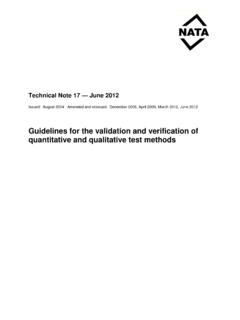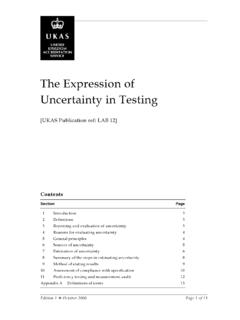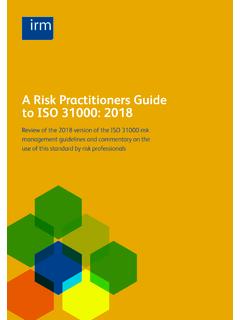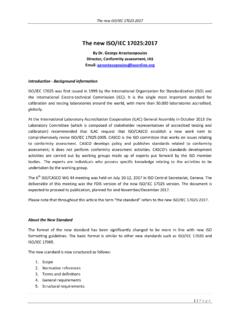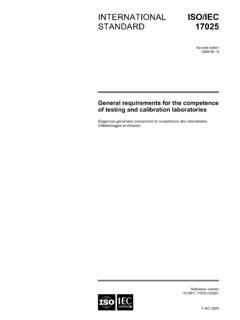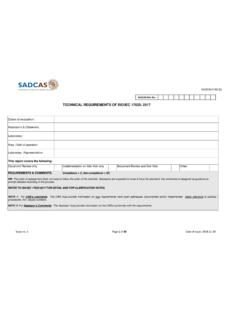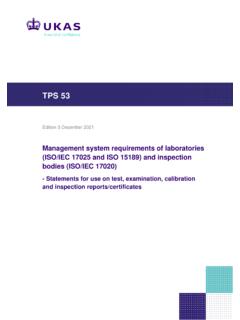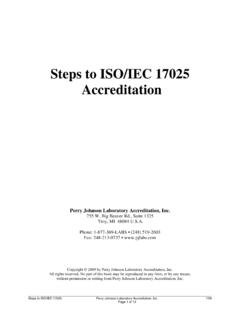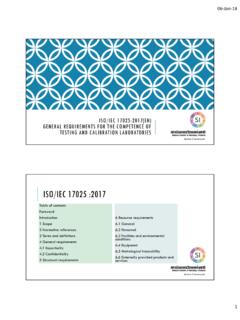Transcription of Understanding and Implementing ISO/IEC 17025
1 Understanding and Implementing ISO/IEC 17025 . A Primer Dr. Ludwig Huber Chief Advisor for Global FDA and ISO/IEC 17025 Compliance Understanding and Implementing ISO/IEC 17025 . Dr. Ludwig Huber Chief Advisor for Global FDA and ISO/IEC 17025 Compliance Preface This primer is intended to give a brief introduction to ISO/IEC 17025 : the global standard for laboratory accreditation. After reading this primer, laboratory managers, staff, and others who might be affected by ISO/IEC laboratory accreditation should: Understand the benefits of laboratory accreditation. Have an overview of management and technical requirements. Know what steps are required to evaluate whether or not laboratory accreditation makes good business sense.
2 Be familiar with implementation steps. Know the types of documentation required. Know how to prepare a laboratory for internal and external audits. The concepts and ideas expressed in this primer are my own and do not necessarily reflect official Agilent or LabCompliance policies. Quality standards are quite dynamic. They are updated every couple of years. Related implementation guidelines, as developed by international committees, are published even more frequently. What is state-of-the art today may not be appropriate tomorrow. A timely update of all information is important and only possible using online information tools. Web sites with regular updates related to quality standards in laboratories include: The Web site of the International Organization for Standardization can be used for ordering ISO standards and other documents.
3 The Web site of the International Laboratory Accreditation Cooperation contains guidance documents with information on the interpretation of accreditation criteria for specific applications. The Cooperation on International Traceability in Analytical Chemistry Web site has downloads that are helpful for Implementing ISO/IEC 17025 . Updated regularly, this Web site includes tutorials relevant to laboratory quality and compliance issues. Dr. Ludwig Huber Chief Advisor for Global FDA and ISO/IEC 17025 Compliance LabCompliance 4. Contents Preface ..4. Management Summary ..7. Main Benefits of Correctly Implemented ISO/IEC 17025 ..8. Requirements Overview.
4 9. Key Steps towards Accreditation ..10. Introduction ..11. Quality Systems ..12. ISO/IEC 17025 Laboratory Quality System ..12. Scope and Contents of this Primer ..14. Management Requirements ..15. Organization ..16. Management System ..16. Document Control ..17. Review of Requests, Tenders, and Contracts ..17. Subcontracting of Tests and Calibrations ..17. Purchasing Services and Supplies ..18. Service to the Customer ..18. Complaints ..19. Control of Nonconforming Testing and/or Calibration Work ..19. Improvement ..19. Corrective Action ..20. Preventive Action ..20. Control of Records ..21. Internal Audits ..22. Management Reviews.
5 22. Technical Requirements ..23. General ..24. Personnel ..24. Accommodation and Environmental Conditions ..25. Test and Calibration Methods and Method Validation ..26. Equipment ..28. Measurement Traceability ..28. Sampling ..29. Handling Test and Calibration Items ..29. Assuring the Quality of Test and Calibration Results ..30. Reporting of Results ..30. 5. Recommendations for Implementation ..31. Organizational Structure ..33. Equipment ..34. Documenting Specifications ..34. Selecting a Vendor ..35. Installation and Documentation ..35. Initial Testing for Calibration and/or Performance Verification ..35. Testing During Ongoing Use.
6 37. Maintenance and Repair ..37. Software and Computer Systems ..37. Measurement Traceability ..39. Measurement Uncertainty ..42. Steps Toward ISO/IEC 17025 Accreditation ..45. Investigation ..47. Implementation ..48. Documentation ..49. Policies and Quality Manual ..52. Processes ..52. Standard Operating Procedures (SOPs) and Work Instructions ..52. Records ..53. Document Control ..53. Internal and External Audits ..55. Internal Audit Schedule ..57. Audit Phases ..57. Dealing with Multiple Regulations and Quality standards ..59. References ..62. Glossary ..63. 6. Management Summary 7. Management Summary ISO/IEC 17025 is the global quality standard for testing and calibration laboratories.
7 It is the basis for accreditation from an accreditation body. The current release was published in 2005. There are two main clauses in ISO/IEC 17025 Management Requirements and Technical Requirements. Management requirements are related to the operation and effectiveness of the quality management system within the laboratory, and this clause has similar requirements to ISO 9001. Technical requirements address the competence of staff;. testing methodology; equipment and quality; and reporting of test and calibration results. Implementing ISO/IEC 17025 has benefits for laboratories, but the work and costs involved should be considered before proceeding.
8 Main Benefits of Correctly Implemented ISO/IEC 17025 : Implementing ISO/IEC 17025 as part of laboratory quality initiatives provides both laboratory and business benefits such as: Having access to more contracts for testing and/or calibration. Some public and private organizations only give contracts to accredited laboratories. Accreditation will also help to get more contracts from organizations that don't mandate accreditation, but do give preference to accredited laboratories in competitive situations. Improved national and global reputation and image of the laboratory. Continually improving data quality and laboratory effectiveness.
9 Having a basis for most other quality systems related to laboratories, such as Good Manufacturing Practices and Good Laboratory Practices. Analytical testing laboratories seeking ISO/IEC 17025 will be impacted in multiple areas. The main difference between good analytical practices and formal accreditation is the amount of documentation to be developed. There is no doubt that any good analytical laboratory uses qualified analysts, checks the performance of equipment used for testing, and validates analytical methods. However, many times the outcome of the tests is not fully documented. ISO/IEC 17025 accreditation requires formal documentation for nearly everything.
10 It is similar to operating in a regulated environment what is not documented is a rumor,' and is viewed by assessors as not being done.'. The overall impact of accreditation on an analytical laboratory can be best illustrated by looking at the whole sample/data workflow. Figure 1 shows a typical laboratory workflow of samples and test data, together with ISO/IEC 17025 requirements. 8. Requirements Overview: ISO/IEC 17025 Requirements for Testing Laboratories Sampling Sample Testing Test Record Handling Reports Maintenance Sampling plan Sample Monitoring Test conditions Ensure & sampling identification & the quality & test results, record integrity documentation protection of of test results with estimated & security sample integrity uncertainty Compliance across all workflow steps Validation of analytical methods & procedures Control of nonconforming testing Equipment calibration testing & maintenance Qualification of personnel Qualification of material Controlled environmental conditions Traceability Written procedures Compliance across the laboratory Documentation control, corrective & preventive actions, complaint handling, supplier & subcontractor management, non-conflicting organizational structure, internal audits Figure 1.
